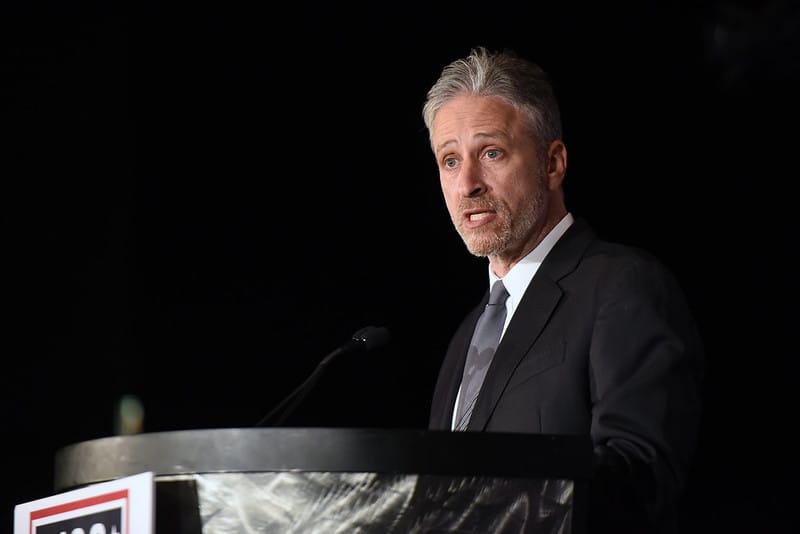
“When I asked people ‘Are you journalists?’ they would say no. But if I asked them ‘Is what is what you do journalistic?’ they say yes, of course.”
By Hanaa' Tameez
Nine years after leaving the show, Jon Stewart recently returned to guest-host “The Daily Show” through the 2024 presidential election. “He’ll help us all make sense of the insanity and division roiling the country as we enter the election season,” Chris McCarthy, the CEO of Showtime/MTV Entertainment Studios, said in an announcement in January.
Stewart may not consider himself a journalist, but news coverage from the early 2000s regularly mentioned how much viewers trusted him. A Pew Research study in 2007 found that “16% of Americans said they regularly watched The Daily Show or the Comedy Central spin-off, the Colbert Report. Those numbers are comparable to some major news programs. For instance, 17% said they regularly watched Fox News’ The O’Reilly Factor, and 14% watched PBS’ NewsHour with Jim Lehrer regularly.”
Regardless, the question “Is news satire journalism?” misses the point, according to researchers at Mid Sweden University and KU Leuven in Belgium. Instead, they say, we should be asking: Is news satire journalistic?
In “Between Headlines and punchlines: Journalistic role performance in Western news satire,” published last month in Journalism Practice, researchers Sara Ödmark and Nicolaï Jonas studied 150 episodes of three different satirical news shows that aired between 2020 and 2023, to evaluate how often and to what extent those shows performed and exhibited journalistic tendencies. Analyzing the shows, they came up with six “roles” based on research from previous studies. For each role, they outlined four to five qualities that “reflect conventional ideal-type journalistic norms and values, while also encompassing aspects connected to the maturation of news satire as a journalistic genre.”
The six roles: Reporter, advocate, watchdog, civic educator, comedic interlocutor and loyalist. The three shows they evaluated were “Last Week Tonight” from the United States, Zondag met Lubach (“Sundays with Lubach“) from the Netherlands, and Svenska Nyheter (“Swedish News”) from Sweden.
As expected, Ödmark told me recently, the role most present in the sampling was that of the comedic interlocutor: a satirist who uses humor, emotion, comedic metaphors, and analogies, while addressing the audience to discuss serious topics.
“Comedy in this case should not be seen as a pejorative obstacle to ‘real’ journalism, but as an expansion of journalistic role performances more in tune with contemporary interpretations of journalisms in the plural,” the study’s authors write.
“These findings empirically strengthen the claim that so-called ’infotainment’ genres are not a deterioration of journalistic quality, but that they play an effective role in ‘inform[ing] citizens about politics and eventually engaging them democratically,’” they add.
Ödmark and I talked about the research, what news satirists and journalists can learn from each other, and the difference between something being journalism and something doing journalism.
Our conversation, edited for length and clarity, is below. Read the full paper here.
HANAA’ TAMEEZ: Tell me a little bit about why you decided to study the role of journalism in Western satire shows.
SARA ÖDMARK: I am a journalist. I teach journalism now, but my research field is political comedy. I wrote my dissertation on the role of political comedians in societal debates. In recent years we’ve seen this development where humor and comedy are being taken more seriously and being considered as part of the societal negotiations. We see it in so many ways that this re-politicization of humor and comedy is more present in all forms of societal debate. I’m interested in the intersection between journalism and comedy. It’s this sort of blurring of boundaries that’s really fascinating to me. It’s sort of been proven in the media landscape of today that comedians have been very successful in this media fragmented landscape to get their points across.
TAMEEZ: You looked at shows from the U.S., Sweden, and the Netherlands. Why those three countries and why the particular shows that you picked?
ÖDMARK: I’m interested in the specific sub-genre of journalistic news satire, which has developed starting with the evolution of “The Daily Show” when Jon Stewart took over, but it has evolved even more from that, becoming more and more sort of journalistic in a sense, and it has had a lot of global success. The Swedish show, for instance, has been very vocal about having “Last Week Tonight” as a role model. It’s just this specific sub-genre that captures this intersection that I’m looking at. The production teams consist of journalists and comedians working together. It’s a cross-pollination of expertise and creative outputs that’s really exciting….It was very good material to look at these blurred boundaries.
TAMEEZ: What do you think are the takeaways from this study for journalists, new satire consumers, and the new satirists?
ÖDMARK: When I talk about this, a lot of journalists have this knee-jerk reaction, like, “So now I need to be funny?”
No, I don’t think journalists need to be funny. I think you need to play to your strengths. Comedy is very difficult. As a journalist, you should strive to be engaging and relevant. But [news satire] is a specific sub-genre. It’s a form of opinion journalism. I wouldn’t say that as a journalist, you should have this feeling that you need to be entertaining…But you should be aware of this genre because [it has] this completely different approach where they are more personal, more emotional, and it allows them to connect with audiences.
[For news satirists], it’s all about what your goals are. Of the people I’ve interviewed, there are two different types. One just wants to be funny and be an entertainer. The other ones want to affect social change and be part of the societal debate and discussion. It’s good to know which type you are. If you want to engage with societal debate, this could be a good avenue for that.
[For consumers], it’s a form of opinion journalism. There’s a huge debate and discussion about journalistic objectivity. In my interviews, the production teams usually say, like, ‘This is a news show. We want to be a news show where you get what you need from last week’s news,’ but it is from a specific point of view.
There’s always been this debate about [whether] people are getting [most or all of] their news from these types of shows. What we have seen is that usually the audience for these kinds of shows are interested in politics and news, so they usually consume other news as well. Sure, there are some people who prefer the entertainment format, but its importance shouldn’t be overstated. You should know that it is a specific point of view, and that’s different in different countries. The American version has a stronger political leaning compared to the Swedish show that is more about being unpredictable. They want to be striking in all directions and not have this ideological core. There are some some differences there. But it’s still not neutral.
One of the findings of the study is that the [presence of the] reporter role, which is that of the neutral observer and disseminator of news — that’s very, very [uncommon in these shows]. They are almost always taking a stance, being emotional and personal. One of the [only] “reporter” indicators we found was that they lay out different sides of an issue. They score high on “advocate,” “watchdog,” and “civic educator.” It’s often educational but it’s subjective.
TAMEEZ: Which of your findings surprised you most?
ÖDMARK: We introduced a new role that I think is interesting to talk about in these contexts, which is the “comedic interlocutor.” It’s not discussed as much when you talk about journalistic roles. There is a “joker” role, which is about being funny, trying to be entertaining, but the interlocutor is more about creating a relationship with the audience — being in dialogue, a friend who guides you through the news, educates you, and helps you strengthen your beliefs.
That was something we saw really strongly with the evolution of “The Daily Show.” It’s what people came there for.
TAMEEZ: Why are these role performances in news satire important to understand now?
ÖDMARK: The media landscape is fragmented and ever-changing. We see these blurring of boundaries and these blurring of the different professional roles and genres, and I think this kind of mapping is helpful because it’s being concrete about what we’re talking about. In my interviews, when I asked people, “Are you journalists?” they would say no. But if I asked them “Is what you do journalistic?” they say yes, of course.
I think it’s helpful to break things down and look at which aspects of journalism are present, and how that helps us assess what this is or isn’t and the function it has in the bigger picture of the media landscape.
TAMEEZ: What are some of the shortcomings of news satire in informing people?
ÖDMARK: That’s the money question. If you go back to humor theory, there’s this idea that humor in a message increases attention to that message, but it also signals unimportance; it increases attention, but it’s also easily dismissed.
That’s why I think this genre is so important, because now it’s more established and the hosts are more established, you don’t have this signal of unimportance anymore. People have some kind of an idea of John Oliver being serious and honest. You know that there is fact-checking involved so you don’t get that dismissiveness that easily. There’s still some of that [questioning if] you should you take them seriously, but that’s changing.
[On] the shortcomings of journalism being more engaging, it’s hard because we have these ideals in journalism of objectivity. You shouldn’t just throw these ideas away, but it’s all about how you do things. We saw in the U.S. in the Trump era that people started seeing journalistic objectivity as a problem when reporting about all these absurdities that happened. They said the comedians are better at at covering Trump because they can call out the absurdities in a more straightforward way, when journalists just couldn’t be as direct.
It’s all about being relevant for your audience. You shouldn’t think too much about being entertaining. It’s more about being relevant and doing the stories that matter to people. There’s always the question of what you can learn from this more personal, more emotional approach. There’s always this balance of how how [far] can you go and still have credibility. The audience is kind of aware that there is no such thing as objectivity; nobody is completely neutral. What they appreciate with news satirists is the transparency [about the] point of view. Transparency is always good in journalism as well.
First published in NiemanLab. You can read the article here.
About the Author
Hanaa' Tameez is a staff writer at Nieman Lab. You can reach her via email (hanaa@niemanlab.org) or Twitter DM (@HanaaTameez).
If you liked what you just read and want more of Our Brew, subscribe to get notified. Just enter your email below.


Related Posts
What We Get Wrong About This Strange Thing We Call Advertising
Jul 02, 2025
The Party as a Person: The Story of ‘Pag Mahal Mo, Akbayan Mo’
May 16, 2025
Frequently-Asked Questions About Advertising – Part VII
Apr 11, 2025